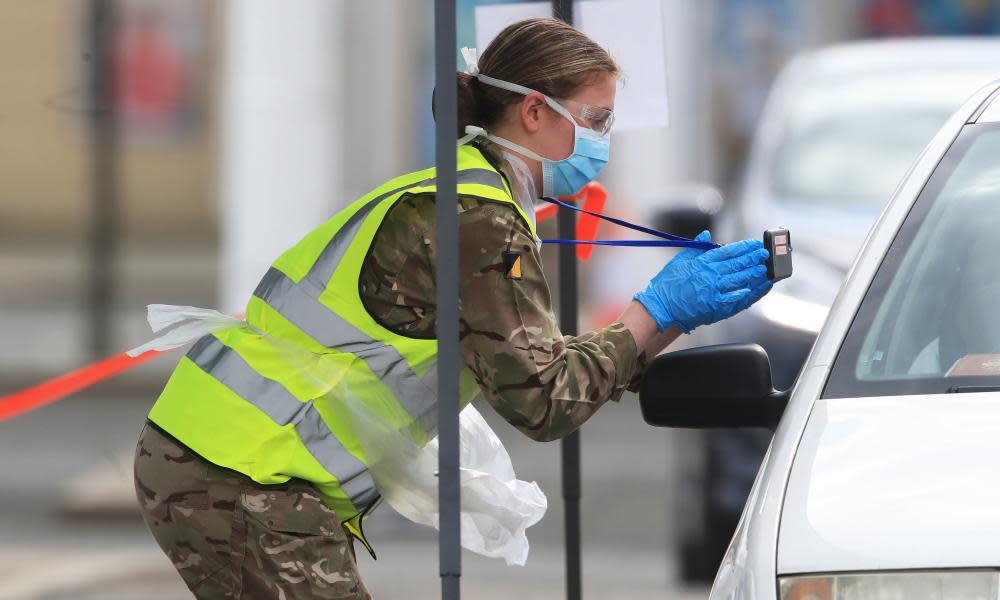Coronavirus tests run out in north-east England as cases surge

Coronavirus tests are running out in parts of north-east England despite cases rising to the highest level in months, political leaders have said amid growing concern over the government’s rationing of tests.
Health officials in Gateshead said tests were running out within two hours of becoming available, by 10am “at the very latest”, despite a recent surge in cases meaning the area has one of the highest infection rates in England.
The Guardian understands that Gateshead’s Queen Elizabeth hospital ran out of chemical reagents for swab tests on Wednesday night and was unable to get a new batch until Friday afternoon. The hospital was only able to continue testing patients when other NHS laboratories stepped in to help.
Martin Gannon, the Gateshead council leader, said the lack of tests was “more than worrying” at a time of rising infections. “We’ve run out of tests,” he said. “It’s diabolical. At a time when we’re opening schools, we’ve got an empty void of tests. You can’t control a situation when you haven’t got the facilities to do it.”
default
Government officials said it was necessary to ration tests to divert capacity towards infection hotspots, such as Greater Manchester, and that it would soon open a new laboratory enabling it to double its swab-testing capacity, to 500,000 a day, by the end of October.
However, scientists said diverting tests away from “low-risk” areas meant any new outbreak would go undetected.
Paul Hunter, a professor of medicine at the University of East Anglia, said: “It is not a good idea to remove testing from areas of low incidence because it means you will miss the early signs of an outbreak.
“If we’re delaying local interventions because testing is being removed, not only does that increase the number of cases but it also extends the period when that particular area might have to go into lockdown.”
Related: Covid job losses could widen England's north-south divide – study
Coronavirus cases in the north-east have reached their highest level since 27 May, according to Public Health England data, with the area recording the sharpest rate of increase of any English region.
It still has a relatively small number of cases overall but areas such as South Tyneside, Middlesbrough, Redcar and Gateshead have some of the highest infection rates in the country and are beyond the threshold where interventions such as lockdown restrictions are imposed.
South Tyneside’s infection rate is the fifth highest in England, at 47.9 cases per 100,000 people, after cases more than doubled to 72 in the week to 2 September. In nearby Gateshead, cases rose to 67 this week, up from 18 last week, yet some residents are being told to drive about 65 miles to Carlisle for their nearest test.
Gannon said test results were taking days to process because they were being sent to a laboratory in Milton Keynes, despite local expertise and capacity being available.
Gannon said a child was tested recently under both the local pillar 1 system at hospital, and the national system: the local result came back within four hours but they were still waiting for the national one more than a week later.
Ian Mearns, the Labour MP for Gateshead, said: “I thought the idea of this public health approach was to nip outbreaks in the bud by getting people tested early, getting them to self-isolate to stop the spread.
“It seems to me that local capacity has been pulled from under our feet. What that says to me is if testing capacity is being rationed then clearly the testing capacity isn’t enough.”
Andy Preston, the Middlesbrough mayor, said people were asking him for help because they could not drive 30 miles for a test. He said it was “massively frustrating” and that the UK was making the safety of the most marginalised people “logistically and financially impossible”.
The Department of Health and Social Care said: “NHS test and trace is working – we are working to increase national testing capacity and hundreds of thousands of people are being tested every day.
“There is a high demand for tests and our laboratories continue to turn test results around as quickly as possible. To make sure we stay in control of this virus we are targeting our testing capacity at the areas that need it most, including those where there is an outbreak, as well as prioritising at-risk groups.”

 Yahoo News
Yahoo News 
